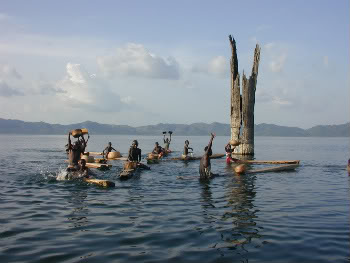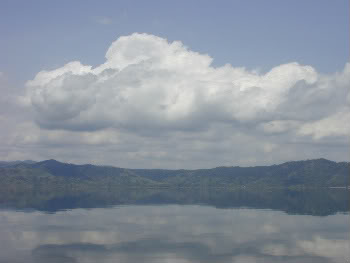|
|
New evidence shows that sub-Saharan West Africa has experienced megadroughts in recent history lasting hundreds of years, far worse than the Sahel drought of the 1970s and 80s which left 100,000 dead.
To uncover West Africa’s past drought patterns, researchers compiled a year-by-year record of the last 3,000 years of climate in West Africa by looking at annually-occurring layers of sediment in Lake Bosumtwi in Ghana.
“What’s disconcerting about this record is that it suggests that the most recent drought was relatively minor in the context of the West African drought history,” says lead author Timothy M. Shanahan, who conducted the research while he was a doctoral student at The University of Arizona in Tucson. According to the study published in Science some of these droughts lasted for centuries, most recently from 1400 to 1750.
 Boys from nearby villages practicing traditional fishing methods on Lake Bosumtwi. Large tropical trees submerged in 15-20 meters of water provide evidence of severe, long lasting droughts just a few centuries ago.Image courtesy of J.T. Overpeck and W. Wheeler, University of Arizona. |
“What’s really striking about droughts in this area is that they last such a long time,” Shanahan said. “You have droughts that last 30 to 60 years, and then some that last four times as long. If we were to switch into one of these century-scale patterns of drought, it would be a lot more severe, and it would be very difficult for people to adjust to the change,” said Shanahan, now an assistant professor of geosciences at the University of Texas at Austin.
The researchers found that devastating droughts normally occurred every 30 to 65 years. A pattern that is expected to continue—and may worsen due to global warming.
Changes in the North Atlantic sea-surface temperature significantly affected the West African monsoon, which alters the climate between wet and dry periods, according to the scientists. By raising sea-surface temperatures, global warming could create more extreme drought conditions, with droughts lasting even longer than those on record.
 View of Lake Bosumtwi, which fills a meteorite impact crater formed 1.09 million years ago and contains an invaluable record of past changes in the West African monsoon. Image courtesy of T.M. Shanahan, University of Texas at Austin. |
“We know that Africa gets long, bad droughts. We also know that global warming will make these droughts a lot hotter. This could be devastating,” says Jonathan T. Overpeck, professor of geosciences and co-director of UA’s Institute for Environment and Society.
Focusing on Lake Bosumtwi, the researchers also looked at geological records and submerged forests, which grew during drought periods when the lake vanished completely for centuries.
Paul Filmer, program director at the National Science Foundation, which helped support the study says that the “project is a good example of how work in the tropics on sediment records provides more detailed insight into climate patterns that affect millions of people in a highly vulnerable area of the world.”
CITATION: “Atlantic forcing of persistent drought in West Africa”. T. M. Shanahan, J. T. Overpeck, K. J. Anchukaitis, J. W. Beck, J. E. Cole, D. L. Dettman,J. A. Peck, C. A. Scholz, J. W. King. Science, Vol 324. April 17, 2009.
Related articles
Revolutionary new theory overturns modern meteorology with claim that forests move rain
(04/01/2009) Two Russian scientists, Victor Gorshkov and Anastassia Makarieva of the St. Petersburg Nuclear Physics, have published a revolutionary theory that turns modern meteorology on its head, positing that forests—and their capacity for condensation—are actually the main driver of winds rather than temperature. While this model has widespread implications for numerous sciences, none of them are larger than the importance of conserving forests, which are shown to be crucial to ‘pumping’ precipitation from one place to another. The theory explains, among other mysteries, why deforestation around coastal regions tends to lead to drying in the interior.
Drought threatens the Amazon rainforest as a carbon sink
(03/05/2009) Drought in the Amazon is imperiling the rainforest ecosystem and global climate, reports new research published in Science. Analyzing the impact of the severe Amazon drought of 2005, a team of 68 researchers across 13 countries found evidence that rainfall-starved tropical forests lose massive amounts of carbon due to reduced plant growth and dying trees. The 2005 drought — triggered by warming in the tropical North Atlantic rather than el Niño — resulted in a net flux of 5 billion tons of carbon dioxide (CO2) into the atmosphere — more than the combined annual emissions of Japan and Europe — relative to normal years when the Amazon is a net sink for 2 billion tons of CO2.
California faces severe drought
(01/30/2009) California appears to be on track for its worst drought since the early 1990s, warned the state’s Department of Water Resources (DWR) following its survey of snowpack and other water resources.
Drought and deforestation in southeast Asia linked to climate change
(12/09/2008) Researchers have linked drought and deforestation in southeast Asia to climate change. Analyzing six years of climate and fire data from satellites, Guido van der Werf and colleagues report that burning of rainforests and peatlands in Indonesia, Malaysia, and Papua New Guinea released an average of 128 million tons of carbon (470 million tons of carbon dioxide – CO2) per year between 2000 and 2006. Fire emissions showed highly variability during the period, but were greatest in dry years, such as those that occur during El Niño events. Borneo was the largest source of fire emissions during the period, averaging 74 million tons per year, followed by Sumatra, which showed a doubling in emissions between 2000 and 2006.
75% of world population to face water shortages by 2050
(04/02/2008) By 2025 more than half of countries will face freshwater stress or shortages and by 2050 as much as 75 percent of the world’s population could face freshwater scarcity, but policy measures and new technologies could help reduce the shortfall, report researchers writing in the journal Nature.
Global warming – not el Nino – drove severe Amazon drought in 2005
(02/20/2008) One of the worst droughts on record in the Amazon was caused by high temperatures in the Atlantic rather than el Nino. The research, published in Philosophical Transactions of the Royal Society B, suggests that human-driven warming is already affecting the climate of Earth’s largest rainforest.